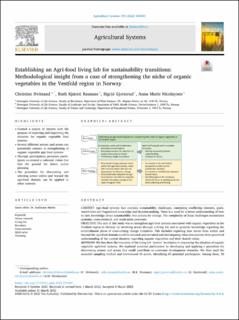| dc.description.abstract | CONTEXT Agri-food systems face complex sustainability challenges, containing conflicting interests, goals, worldviews and fragmented knowledge and decision-making. There is a need for a better understanding of how to turn knowledge about sustainability into actions for change. The complexity of these challenges necessitates systemic, cross-sectorial, and multi-actor processes. OBJECTIVE The aim of this study was to strengthen agri-food systems associated with organic vegetables in the Vestfold region in Norway by involving actors through a living lab and to generate knowledge regarding the establishment phase of cross-cutting change initiatives. This included exploring how actors from within and beyond the agri-food domain could be selected and recruited and investigating what characterize their perceived understanding of the current situation regarding organic vegetables and their shared vision. METHODS We first drew the boundary of the living lab “system” in relation to improving the situation of organic vegetable agri-food systems. We explored potential participants by developing and applying a procedure for discovering sectors and actors that could contribute to overcome development obstacles. We then used the snowball sampling method and interviewed 48 actors, identifying 80 potential participants. Among these, 30 actors participated in a workshop in which we facilitated co-creative processes for creating a common problem understanding and a shared vision. RESULTS AND CONCLUSIONS The procedure helped identify change-oriented actors within the agri-food domain. Actors represented small-scale entities who had power to influence their own business, as well as individuals within large-scale entities with limited power to influence change in own organizations. We also discovered actors beyond the agri-food domain who did not originally identify themselves closely with the topic of organic food, such as actors from waste management, education, regional, business, and tourism development, and health and welfare. The diversity of actors contributed to a rich and holistic perspective on the current situation for agriculture and food. They co-created a manifold, but coherent, shared vision, portraying a more collaborative orientation in localized agri-food systems. The gaps between current and future desired situations clearly served as a starting point for action planning and testing. SIGNIFICANCE The study shows crucial steps in establishing an agri-food living lab, including introductory work of bounding the system, selecting actors, and conducting co-creative processes. The study developed and applied a procedure for discovering actors within and beyond the agri-food domain who could contribute to overcoming development obstacles. This procedure can be adjusted and utilized in other settings. | |
